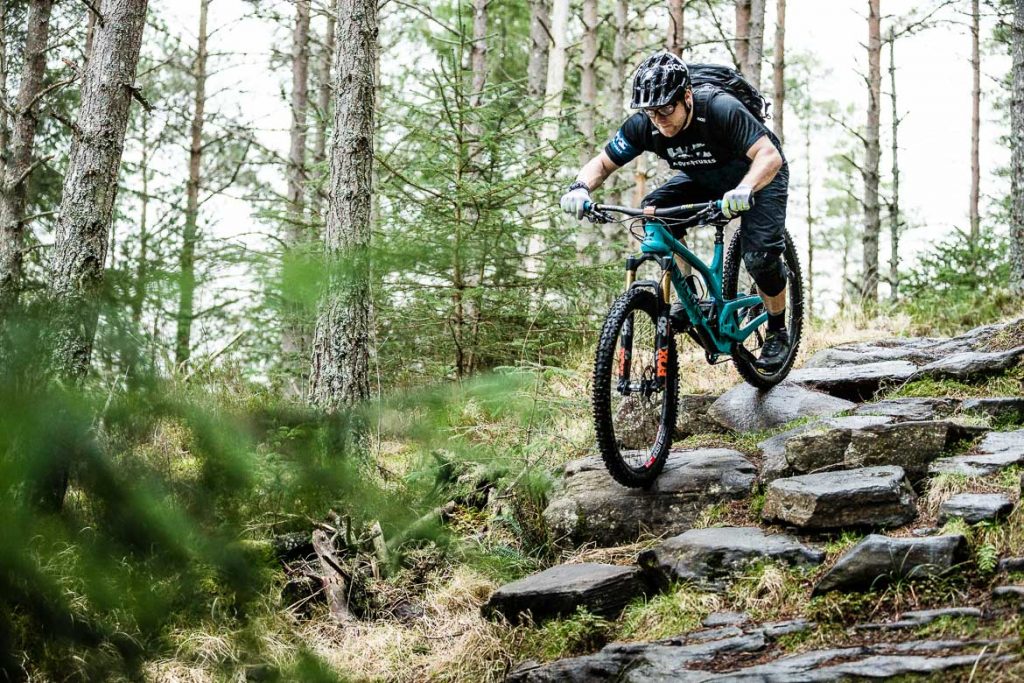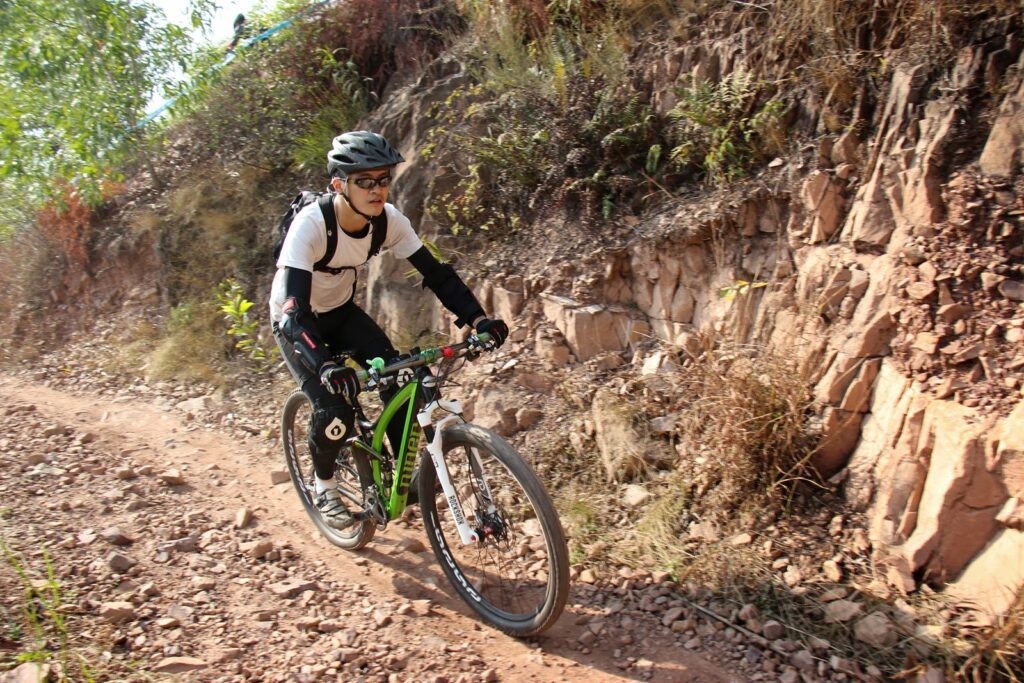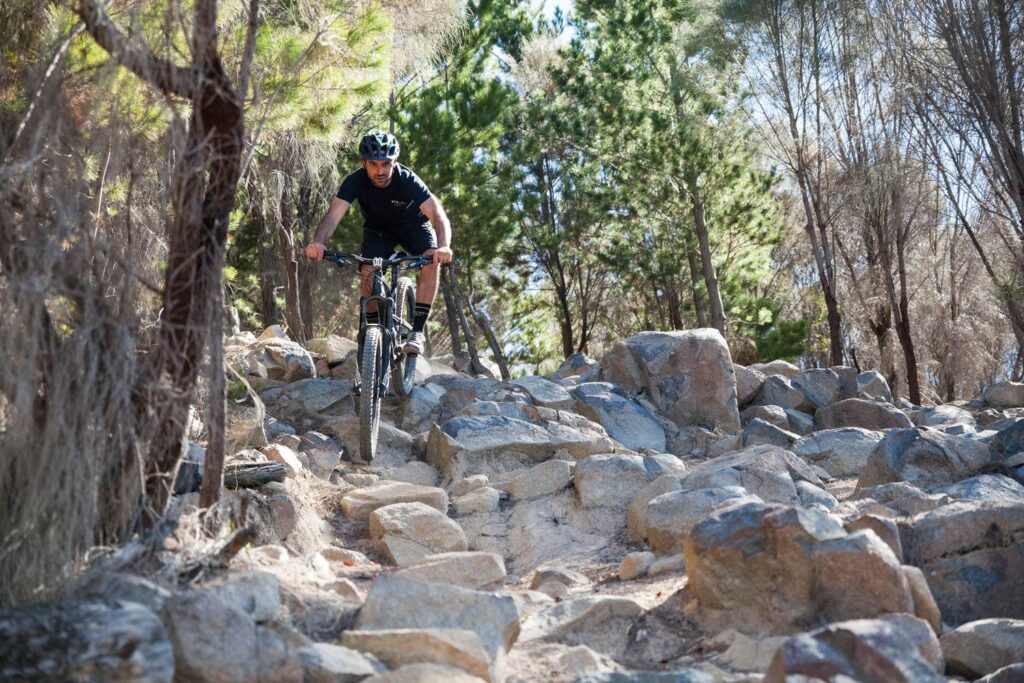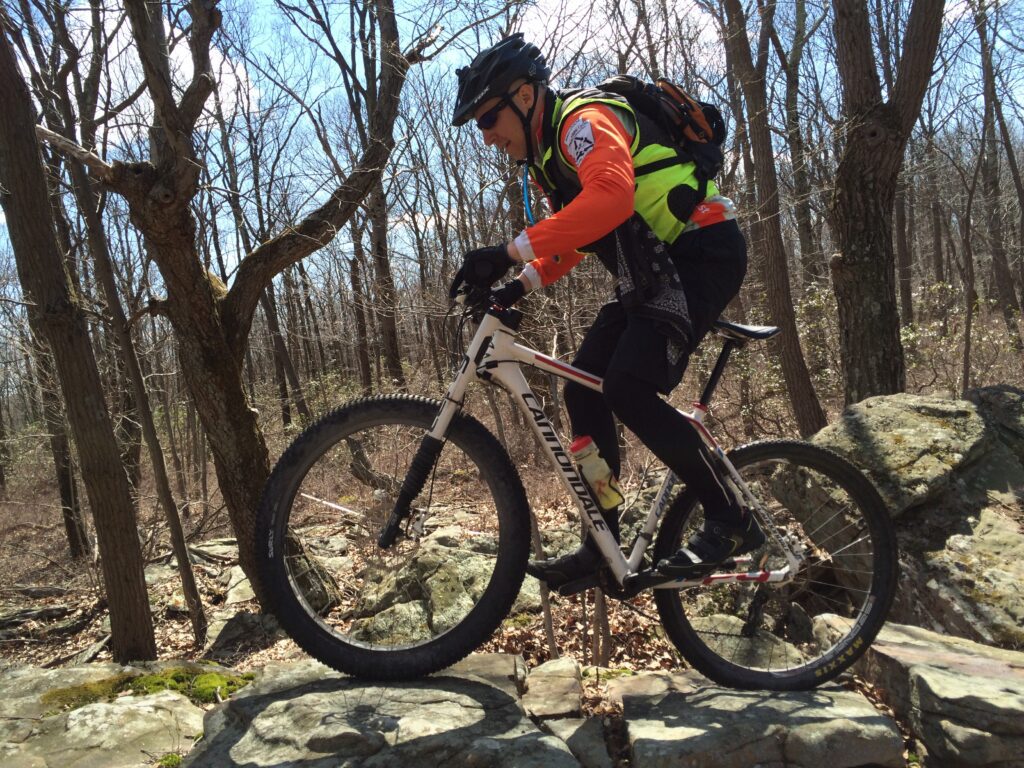


Riding a mountain bike over rocky terrain is a thrilling and challenging adventure, but it requires a specific skill set and knowledge to navigate those rugged paths successfully. If you’ve ever wondered, “How to ride over rocks on a mountain bike?” you’re in the right place.
To ride over rocks on a mountain bike, maintain balance, keep cranks level, look ahead, choose a smooth line, use momentum, and practice proper body positioning.
Rocky trails are known for their technical difficulty, demanding your utmost attention, precision, and control. Whether you’re a beginner looking to venture into more challenging terrain or an experienced rider seeking to hone your skills, this guide will provide you with valuable insights and techniques to conquer those rocky obstacles.
In the following sections, we’ll delve into the key aspects of riding over rocks, including proper bike setup, body positioning, selecting the right line through a rock garden, essential equipment, and effective riding techniques.
By the time you finish reading, you’ll be better prepared to tackle rocky trails with confidence and finesse. So, let’s get started on your journey to mastering the art of riding over rocks on a mountain bike.
Read More: How to ride uphill on a mtb
Proper Bike Setup for Riding Over Rocks: A Guide to Terrain-Ready Mountain Biking



When you’re venturing into rocky terrain on your mountain bike, having the right bike setup can make all the difference between a thrilling ride and a challenging struggle. Proper bike setup not only enhances your performance but also ensures your safety on rugged trails.
In this guide, we’ll delve into the essential aspects of setting up your mountain bike for conquering rocky paths.
Tire Pressure:
Adjusting your tire pressure is crucial. Lower tire pressure provides better traction on rocky surfaces, allowing your tires to conform to the terrain for improved grip. However, be mindful not to go too low, as it can lead to pinch flats.
Suspension Settings:
Fine-tuning your suspension settings is essential for absorbing impacts from rocks and maintaining control. Experiment with your fork and rear shock settings to find the right balance between responsiveness and damping.
Drivetrain Maintenance:
Ensure your drivetrain is well-maintained. A smoothly functioning chain and drivetrain components are vital for consistent pedaling power, especially when negotiating rocky obstacles.
Brake Check:
Your brakes should be in top condition. Reliable stopping power is essential on rocky descents. Check brake pad wear, and bleed the hydraulic system if necessary.
Frame and Components:
Consider a bike with a sturdy frame and durable components designed for off-road riding. Robust materials and construction can withstand the rigors of rocky trails.
Protection Gear:
Invest in proper protection gear, including a quality helmet, gloves, and knee and elbow pads. Rocks can be unforgiving, so safety is paramount.
With your mountain bike set up correctly, you’ll be better prepared to tackle rocky trails with confidence and ease. Adjust your tire pressure, fine-tune your suspension, and maintain your drivetrain for a smoother ride.
Combine this setup with proper riding techniques, and you’ll be well on your way to conquering even the most challenging rocky terrain.
Read More: How to get better at downhill mountain biking
Mastering Rocky Terrain: Techniques for Riding Over Rocks



Riding over rocky terrain is an exhilarating aspect of mountain biking that presents unique challenges. To conquer these obstacles and elevate your riding skills, it’s crucial to master specialized techniques.
In this guide, we’ll explore the art of navigating rocky trails and provide you with the expertise needed to tackle rocky terrain confidently.
Body Positioning:
Maintaining the right body position is paramount. Keep your weight centered over the bike, knees, and elbows slightly bent, and your chest lowered but not touching the handlebars. This balanced posture ensures stability and control.
Crank Position:
To avoid striking rocks, keep your cranks level. This means positioning your pedals horizontally as you ride over obstacles. It minimizes the chances of pedal strikes and maintains a smoother line.
Line Choice:
Choose your path carefully. Scan the trail ahead to identify the smoothest line through the rocky terrain. Look for gaps between rocks or smoother surfaces to maintain momentum.
Momentum:
Speed is your friend when riding over rocks. Maintaining a controlled pace helps your bike roll over obstacles more smoothly. Find a rhythm that suits the terrain without pedaling too hard.
Anticipate Terrain:
Look beyond the immediate obstacles. By focusing on the trail ahead, you can anticipate upcoming rocks and prepare your body and bike for the challenges they pose.
Relaxed Riding:
Stay relaxed on your bike, particularly your arms and legs. Use them as shock absorbers to soak up the impacts of rocky terrain. Avoid gripping the handlebars too tightly.
Unweighting:
As you approach a rock, shift your weight slightly backward and lift the front wheel to “unweight” it. This technique helps the front wheel clear the obstacle smoothly.
Practice:
Riding over rocks is a skill that develops with practice. Start on less technical trails and gradually progress to more challenging ones as your skills improve. Don’t rush the learning process.
By mastering these techniques and incorporating them into your riding style, you’ll not only navigate rocky terrain with finesse but also enhance your overall mountain biking experience. Remember that practice, patience, and a sense of adventure are your best allies in conquering rocky trails.
Read More: How to become a better mountain biker
Choosing the Right Line: Picking Your Path Over Rocks



Navigating rocky terrain on a mountain bike isn’t just about brute force; it’s a strategic dance between your bike and the trail. One of the most crucial skills to develop is the ability to choose the right line through the rocks.
Read More : ” Can you ride a mountain bike anywhere? “
Here, we’ll explore the art of line selection and how it can make your rocky trail rides more enjoyable and efficient.
Scan Ahead:
As you approach rocky sections, always keep your eyes scanning ahead. Look for the smoothest and least rocky path through the terrain. The more you can anticipate, the better you’ll be at line selection.
Seek the Gaps:
In rocky terrain, gaps between rocks or smoother surfaces are your allies. These are the paths of least resistance and should be your preferred lines. They allow for better traction and smoother rolling.
Plan Ahead:
Think a few moves ahead, like in a game of chess. Plan your line choices based on what’s coming up. If you see a big rock, consider the path around it, even if it’s not immediately in front of you.
Maintain Momentum:
Momentum is your friend on rocky trails. While it might be tempting to slow down, sometimes maintaining speed helps you roll over rocks more smoothly. Picking a line that supports your momentum is often the right choice.
Avoid Square Edges:
Sharp, square-edged rocks are tricky to navigate. They can easily stop your progress or cause a pinch flat. Aim to ride over rocks at an angle or choose lines that allow you to roll over their smoother edges.
Experiment:
Don’t be afraid to experiment with different lines. As you gain experience, you’ll develop a feel for what works best for your riding style and the specific trail conditions.
Adapt to the Trail:
Each rocky trail is unique. What works on one may not work on another. Be ready to adapt your line selection based on the specific challenges of the trail you’re riding.
Mastering the art of line selection is a skill that comes with practice and experience. As you become more attuned to the nuances of rocky terrain, you’ll find yourself effortlessly flowing through the rocks, making your mountain biking adventures all the more enjoyable.
So, keep your eyes ahead, seek the gaps, and choose your lines wisely.
Building Confidence: Tips for Tackling Rocky Challenges



Riding over rocky terrain is an exhilarating aspect of mountain biking, but it can also be intimidating for riders, especially those new to the sport. Building confidence to tackle rocky challenges is key to expanding your riding repertoire.
In this guide, we’ll share valuable tips to help you conquer rocky trails with skill and assurance.
Start Small:
If you’re new to rocky terrain, begin with less technical trails featuring smaller rocks. Gradually work your way up to more challenging routes as your confidence and skills grow.
Master Fundamental Skills:
Ensure you have a strong foundation in basic mountain biking skills, including balance, braking, and body positioning. These skills provide the essential building blocks for rocky trail success.
Develop Trail Awareness:
Pay close attention to the trail ahead. Anticipate rocky sections and plan your approach. Being aware of upcoming challenges allows you to make calculated decisions.
Choose Your Line:
As mentioned earlier, line selection is crucial. Look for smoother paths through the rocks and avoid overly technical sections until you’re comfortable.
Use Your Gears:
Proper gear selection is vital when navigating rocky terrain. Use lower gears to maintain momentum and control. Shift as needed to match the gradient and obstacles.
Build Technical Skills:
Practice specific skills like “rock gardens.” Find a trail or section with rocks and ride it repeatedly to refine your technique and build confidence.
Stay Relaxed:
Tension in your body can hinder your ability to flow through rocks smoothly. Keep your grip on the handlebars light, relax your arms, and let your bike move beneath you.
Learn from Others:
Ride with experienced mountain bikers or consider taking a skills clinic. Observing and learning from others can provide valuable insights and boost your confidence.
Visualize Success:
Before tackling a rocky section, visualize yourself riding through it smoothly. Positive mental imagery can help you overcome mental barriers.
Embrace Setbacks:
It’s natural to encounter challenges and setbacks when riding rocky terrain. Don’t be discouraged by falls or mistakes. Use them as learning opportunities to improve.
Building confidence on rocky trails takes time and practice. Remember that every rider progresses at their own pace. The key is to stay patient, persistent, and open to learning. With dedication, you’ll soon find yourself confidently conquering rocky challenges and enjoying the exhilaration they bring to your mountain biking adventures.
Riding Over Rocks Safely: Key Considerations and Techniques



Mountain biking over rocky terrain is an exciting and challenging endeavor that requires both skill and caution. To ensure a safe and enjoyable ride, it’s crucial to consider specific factors and employ the right techniques.
In this guide, we’ll explore key considerations and techniques for safely navigating rocky trails.
Proper Equipment:
Before hitting rocky trails, make sure your mountain bike is well-maintained. Ensure your tires are adequately inflated, brakes are functioning correctly, and suspension is adjusted for the terrain.
Protective Gear:
Safety should be a priority. Wear appropriate protective gear, including a helmet, gloves, knee and elbow pads, and sturdy footwear. These items can significantly reduce the risk of injury in case of a fall.
Tire Pressure:
Adjust your tire pressure for rocky terrain. Slightly lower tire pressure provides better traction and shock absorption. Be cautious not to go too low, which can lead to pinch flats.
Body Position:
Maintain a balanced and centered body position over the bike. Keep your weight slightly back, bend your knees, and keep your elbows out to absorb shocks and maintain control.
Choose Your Line:
Carefully select your path through the rocks. Look for the smoothest line with fewer obstacles. Avoid sharp, jagged rocks and opt for gaps or smoother surfaces.
Momentum:
Maintain a controlled but steady pace. Momentum is your ally when riding over rocks. It helps you roll over obstacles more smoothly and maintain stability.
Climbing Techniques:
When climbing over rocks, keep your weight forward to prevent the front wheel from lifting. Use a combination of pedaling and weight shifts to maintain traction.
Descending Techniques:
On descents, lower your saddle to get behind it, keeping your weight back. Use both brakes judiciously, favoring the rear brake to prevent skidding.
Practice Balancing:
Improve your balance by practicing riding slowly over rocks in a controlled environment. This can enhance your ability to navigate technical sections with finesse.
Mental Focus:
Stay mentally focused and alert on rocky trails. Keep your eyes ahead, scanning the terrain for the best line. Maintain a calm and confident mindset to react to challenges effectively.
Communication:
If riding with others, communicate clearly about your intended line and actions. This helps prevent collisions and ensures a safer riding experience.
Riding over rocks safely is a skill that develops with experience and practice. Always start with less technical trails and progressively tackle more challenging terrain as you gain confidence. Remember that safety should be your top priority, and if a section feels too challenging, dismount and walk your bike.
As you build your skills and experience, you’ll find rocky trails to be both thrilling and rewarding.
Conclusion:
In conclusion, mastering how to ride over rocks on a mountain bike is a skill that combines equipment, technique, and experience. By understanding the necessary gear, honing your riding skills, and staying safe on the trail, you can tackle rocky terrain with confidence.
Remember to start on less technical trails and gradually progress to more challenging routes as you build your proficiency. Riding over rocks can be both a thrilling adventure and a test of your abilities, making it a rewarding aspect of mountain biking for riders of all levels.
So, equip yourself properly, practice your skills, and embrace the rocky challenges that await – you’re on your way to becoming a more skilled and adventurous mountain biker.
“Get ready to roll and rock on your mountain bike as we unveil the secrets to confidently conquering nature’s rugged obstacles, one pedal at a time.”
FAQs:
Can mountain bikes go over rocks?
Yes, mountain bikes are designed to go over rocks, thanks to their sturdy construction and suspension systems.
How do you ride loose rocks on a mountain bike?
Ride loose rocks with a relaxed grip, slight front wheel lift, and balanced weight distribution for control.
How do you ride a mountain bike over obstacles?
Ride over obstacles by approaching them at the right angle, unweighting the front wheel, and using the proper technique for bunny hopping or rolling over.
How do you ride rock rolls on a mountain bike?
Ride rock rolls with controlled speed and a balanced body position, allowing the bike’s suspension to absorb impacts.
How do mountain bikers go uphill?
Mountain bikers go uphill by pedaling with efficient gear ratios, maintaining a steady pace, and occasionally using techniques like standing on pedals for extra power.



Welcome to Bikegenics, where passion meets performance! We are a leading online destination for all things related to mountain biking, dedicated to providing you with top-notch gear, expert advice, and an immersive community to fuel your two-wheeled adventures. With a commitment to excellence and a deep love for the sport, we strive to elevate your biking experience to new heights.
